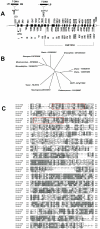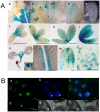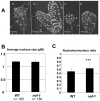NOF1 encodes an Arabidopsis protein involved in the control of rRNA expression
- PMID: 20877469
- PMCID: PMC2942902
- DOI: 10.1371/journal.pone.0012829
NOF1 encodes an Arabidopsis protein involved in the control of rRNA expression
Abstract
The control of ribosomal RNA biogenesis is essential for the regulation of protein synthesis in eukaryotic cells. Here, we report the characterization of NOF1 that encodes a putative nucleolar protein involved in the control of rRNA expression in Arabidopsis. The gene has been isolated by T-DNA tagging and its function verified by the characterization of a second allele and genetic complementation of the mutants. The nof1 mutants are affected in female gametogenesis and embryo development. This result is consistent with the detection of NOF1 mRNA in all tissues throughout plant life's cycle, and preferentially in differentiating cells. Interestingly, the closely related proteins from zebra fish and yeast are also necessary for cell division and differentiation. We showed that the nof1-1 mutant displays higher rRNA expression and hypomethylation of rRNA promoter. Taken together, the results presented here demonstrated that NOF1 is an Arabidopsis gene involved in the control of rRNA expression, and suggested that it encodes a putative nucleolar protein, the function of which may be conserved in eukaryotes.
Conflict of interest statement
Figures








References
-
- Meinke DW. Molecular-Genetics of Plant Embryogenesis. Annual Review of Plant Physiol and Plant Mol Biol. 1995;46:369–394.
-
- Jurgens G, Mayer U, Busch M, Lukowitz W, Laux T. Pattern formation in the Arabidopsis embryo: a genetic perspective. Philos Trans R Soc Lond B Biol Sci. 1995;350:19–25. - PubMed
-
- Lepiniec L, Devic M, Berger F. Plant Functional Genomics. Binghamton: Food Products Press; 2005. Genetic and Molecular Control of Seed Development in Arabidopsis. pp. 511–564.
Publication types
MeSH terms
Substances
LinkOut - more resources
Full Text Sources
Molecular Biology Databases

